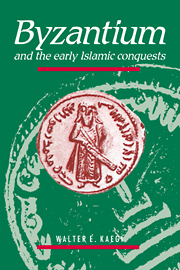Book contents
- Front Matter
- CONTENTS
- List of illustrations
- Preface
- List of abbreviations
- Chapter 1 The problem of Byzantium and the early Islamic conquests
- Chapter 2 The Byzantine Empire in an era of accelerating change
- Chapter 3 Difficulties in devising defenses for Syria
- Chapter 4 The first Muslim penetrations of Byzantine territory
- Chapter 5 Early tests in southern Palestine
- Chapter 6 Problems of cohesion: the battle of Jābiya- Yarmūk reconsidered
- Chapter 7 The brief struggle to save northern Syria and Byzantine Mesopotamia
- Chapter 8 Byzantium, Armenia, Armenians, and early Islamic conquests
- Chapter 9 Controversy and confidence in the seventh-century crisis
- Appendix 1 Author and date of the anti-jewish treatise
- Chapter 10 Elements of failure and endurance
- Bibliography
- Index
Chapter 8 - Byzantium, Armenia, Armenians, and early Islamic conquests
Published online by Cambridge University Press: 22 September 2009
- Front Matter
- CONTENTS
- List of illustrations
- Preface
- List of abbreviations
- Chapter 1 The problem of Byzantium and the early Islamic conquests
- Chapter 2 The Byzantine Empire in an era of accelerating change
- Chapter 3 Difficulties in devising defenses for Syria
- Chapter 4 The first Muslim penetrations of Byzantine territory
- Chapter 5 Early tests in southern Palestine
- Chapter 6 Problems of cohesion: the battle of Jābiya- Yarmūk reconsidered
- Chapter 7 The brief struggle to save northern Syria and Byzantine Mesopotamia
- Chapter 8 Byzantium, Armenia, Armenians, and early Islamic conquests
- Chapter 9 Controversy and confidence in the seventh-century crisis
- Appendix 1 Author and date of the anti-jewish treatise
- Chapter 10 Elements of failure and endurance
- Bibliography
- Index
Summary
THE CONTEXT
The Muslim invasions and conquest of Byzantine Armenia in the seventh century become intelligible only in light of the Muslim conquest of Byzantine Mesopotamia and, to a lesser extent, of northern Syria. Byzantine Armenia was not initially an object in and of itself, even though it possessed some valuable assets. Armenia did contain rich pasturelands, despite its formidable winters. It possessed livestock, minerals, timber, and manpower, which was even more valuable because of the loss of Mesopotamia with its recruiting ground for friendly Arabs, and it dominated some key trade routes as well as strategic mountains. Booty in Armenia was probably not the main Muslim objective, at least at the strategic level. Its timber may have been too difficult to transport out of Armenia on a cost-effective basis. The Muslim invasion and conquest of Armenia was a consequence of and inextricably connected with the consolidation of power in Mesopotamia and made strategic sense. The Muslim invasion and conquest of Georgia derived from opportunities discovered in the wake of the conquest of Armenia.
The evidence for Heraclius' interest in Armenia and his fellow Armenians is overwhelming. Although his birthplace and his exact date of birth (c. 575) are uncertain, his father, also named Heraclius, may have come from Theodosiopolis (Erzurum). Heraclius summoned and personally attended a synod at Theodosiopolis in 633 to unify the Armenian church with his Monothelite one.
- Type
- Chapter
- Information
- Byzantium and the Early Islamic Conquests , pp. 181 - 204Publisher: Cambridge University PressPrint publication year: 1992

